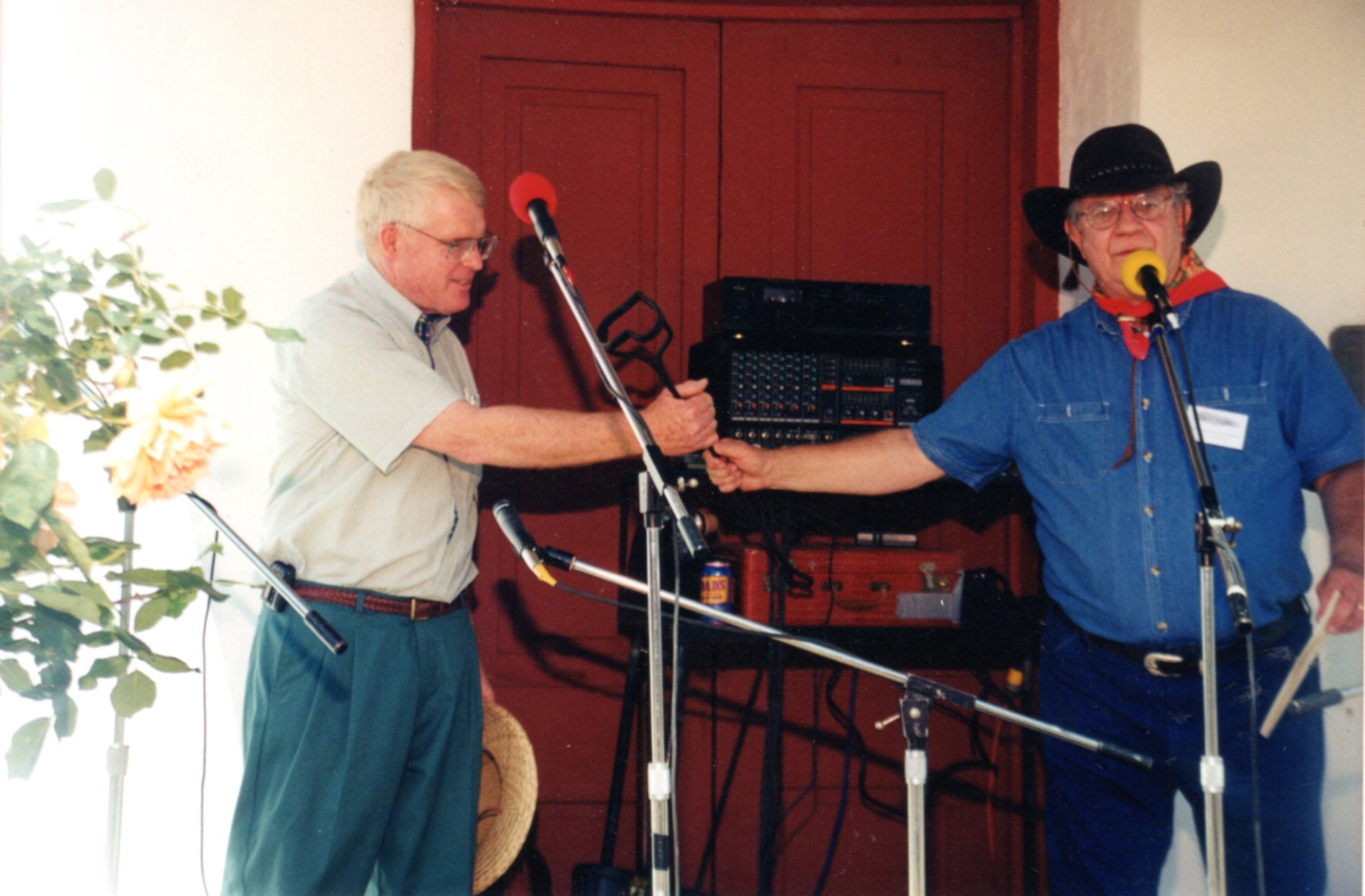| |

|
Vail Ranch Restoration
Association (Now merged into the Temecula Valley Historical Society) |
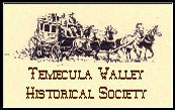



| About VaRRA |
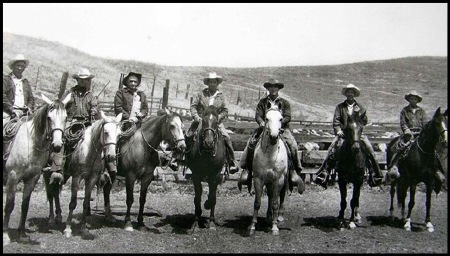
| "The Magnificent Seven" - photograph by Sam Hicks circa 1947 |
| The History of Vail Headquarters |
| By Rebecca Marshall Farnbach |
A long
time ago this area was home to Native American people who lived in
family groups who traveled to where there was water and food. Padres from the San Luis Rey Mission discovered the Temecula Valley in 1797. They claimed the land and started growing grain here. Visitors passed through the area on the only road from the 1840s through the 1860s, a road known by several names: The Southern Emigrant Trail, the Fort Yuma Road and eventually the Butterfield Trail. The reason the road was located there is because it forded the river at that location, one of only three places where the Temecula Creek could be crossed without the danger of quicksand. In the 1840s the Mexican government who controlled the Temecula Valley, gave numerous land grants to prominent citizens throughout California. There were four grants in the Temecula Valley: The Little Temecula Rancho, the Temecula Rancho, Rancho Pauba and the Santa Rosa Rancho. The Little Temecula Rancho was granted to Pablo Apis, a Native American man who was from Rancho Guajome in the Oceanside area. As travelers came along the Southern Emigrant Trail, some stayed to make Temecula their home. One such visitor was Louis Wolf, who eventually controlled the 2,200-acre Little Temecula Rancho. Wolf bought out a previous storekeeper Julius Zubinski in 1867. Since then, the adobe building been called the Wolf Store. The adobe general store also housed the Temecula post office and had hotel rooms along the south side for travelers. The Wolfs built a house next door that became the central portion for the present-day Cookhouse and we have found evidence that he also had a one-room schoolhouse that was later moved from behind the Wolf Store to adjoin the Wolf home. Louis Wolf, a Jewish German, and his wife Ramona, who was half-Indian, gave lodging to the author Helen Hunt Jackson (HHJ)who was on assignment by the US Congress to investigate the treatment of Native people in the southwest region of the US. This assignment produced her book A Century of Dishonor. When HHJ later wrote her fictional account, the book Ramona, she opened with sheep shearing time in Temecula, and featured a store run by a burly German and his half-Indian wife named Ramona very close to an Indian cemetery. There is an Indian cemetery within walking distance of the Wolf Store. Although Ramona is a book of fiction and a composite of people, places and events, there is undeniable reference to Hunt's experiences in Wolf's Temecula. For anyone who does not know, the location now called the Vail Headquarters was the town of Temecula prior to what we now call Old Town Temecula. The Temecula of the Wolf family began in the 1860s while the New Town of Temecula, now called Old Town began in 1882 when the rail lines were put through at the base of the western hills 2.5 miles from the Wolf Store. Before we move to more recent history, I want to mention two more hugely important connections to the property. The Mormon Battalion was a volunteer army that marched overland from Council Bluffs, Iowa to assist with the Mexican-American War in 1846-47. It was the longest ever military march on the continental US. As the Mormon Battalion approached Temecula they came upon the aftermath of a Native vs. Native battle. The story goes that the battalion stood guard as the Temecula Indians carried away their dead and buried them. The cemetery is now behind unmarked walls in the shopping center behind Corner Bakery Café in south Temecula. The next era of importance was the Vail era. There were short-term owners and renters of the ranchland surrounding the Wolf Store in the late 1800s and going into the early 1900s. A notable one rancher was Jacob Ludy. From 1904 to 1964 the Vail Company owned the land. They bought up 87,500 acres for grazing cattle that they fattened and shipped to market. Roughly, the Vail Company owned everything from Temecula Parkway to Clinton Keith Road, from Camp Pendleton to past Vail Lake with the exceptions of Old Town Temecula, Historic Downtown Murrieta and ranches the Murrieta Creek. This included nearly all the acreage of the four Mexican land grants in the Temecula Valley. The Vail Headquarters Site was often called the Pauba Ranch at that time. Company business took place there. In the 1910s they built a bunkhouse, cookhouse, barns, an office, a foreman's house and a meteorology building. The meteorology building was need to study rainfall and the volume of water in the Temecula Creek to comply with a water lawsuit that the owners of the future Camp Pendleton waged against the Vail Company. The Wolf Store was used for storage during the years the Vail Company owned the property. The Vail Company sold their holdings in 1964 for $23 million to Kaiser Aetna to design the planned community of Rancho California. Not a bad price for 87,500 acres. Kaiser Aetna drafted subdivisions designating where each agricultural product would be grown (avocados, grapes, citrus) and designating business areas and housing areas, and horse ranch properties. Glen Oaks properties would be 10 acres, Los Ranchitos 5 acres and Meadowview 1.5 acre lots. In 1989 Temecula voted for cityhood and selected the historical name Temecula. It was at first assumed that Murrieta would be incorporated as part of the City of Temecula, but soon leaders in Murrieta decided to incorporate their distinctively different city. Murrieta incorporated in 1990. The Vail HQ sat empty and unused after the Vail Company sold the property in 1964. Renters lived onsite to protect it from vandalism. Pam Malnar lived there, and more recently, Mary Jo Costilow lived in the foreman's house. In April, 1997 some concerned residents raised a vocal alarm over the rundown conditions of the building and the ranch site. They learned that the new owner of the site, MDC Vail, had designs to remove all the historical buildings except the Wolf Store. Although Jerry Swanger and Jerry Morris of MDC Vail had been told by the County of Riverside in 1989 that were required to preserve the historical buildings, they said they would only restore the Wolf Store and tear down the others. Things came to the Farnbachs' attention in June 1997 when we read a letter to the editor in The Californian stating that all the deteriorating buildings on the Vail HQ site should be removed. The reason stated was they were filled with mice, disease and probable Hanta virus. We wrote a response that appeared in The California five days later explaining why the buildings and site should be saved. In rereading our letter to the editor today, we see we had a lot of our facts wrong, but our hearts were in the right place. "It would make a wonderful heritage park to augment the tourist-friendly vineyards and Old Town Temecula and to provide students with a firsthand look at the history of this valley. "Under no circumstances should these history-rich buildings be destroyed. If some government or private agency will provide the funding for renovation, we volunteer to help clean it up and to provide docent tours." Well, after that went to print our lives were never the same! Shortly after our letter to the editor was printed, we received an invitation to meet with the group of concerned citizens in the private room at the back of the Pechanga Buffet when they only had a tent for a casino. The group had met three times before we attended. There were about 12 people at the meeting and we discussed various ideas for how the Vail HQ property could ideally be used. We wanted a 30 to 40-acre historic park, but when we asked the city, county and state, no one had interest in it. We consulted with the City of Temecula, although the property was not in city limits until an annexation of the area a few years later. Things came to a head in April 1998 when we learned that MDC Vail wanted to bulldoze an adobe portion of the foreman's house. We called Jerry Swanger who said it was not historical, that it was built in 1958. I called Walter Vail's grandson who said it was constructed in 1926. Swanger laughed at me when I gave him the information and within a couple of days a hole was dug and the adobe portion of the foreman's house was no more. Out of concern for the rest of the structures so we filed a lawsuit against MDC Vail for the demolition and against the County of Riverside for issuing permits that allowed the demolition. There were four of us who committed ourselves to the suit: Dick Diamond, Rita Gentry, and Darell and Rebecca Farnbach. Rita, an archeologist, was the only one experienced with lawsuits against modern development. She still owns the adobe house of her great-grandfather Harry Hind, a Murrieta pioneer. Dick, a Temecula resident, taught high school history in Riverside. Darell was a hairdresser and I was a medical tech and surgical assistant. We decided Darell & Dick would be the plaintiffs. They had the most time. We decided Rita's name on the case would possibly be a negative since she was known to be anti-development. We had a pro bono lawyer for about two weeks, but we parted ways when we saw that he was protesting development and did not capture our vision for preservation. The four of compiled evidence of the significant importance of the site. We met every Sunday afternoon in our home from March through November 1998, even on Easter, Mother's Day, and Father's Day. We asked for 30 acres to be saved, no further demolition, and renovation to be done according to the US Dept. of Interior standards so the site would continue to be eligible for nomination as a National Historic Site. It was our belief that if it could not be a park run by a governmental agency, then it should be patterned after Old Town San Diego, with retail businesses to pay for the upkeep of the property. Our case, all the historical documentation to justify our position, filled a banker's box. The County had attorneys from Sacramento defend them against us. We were banned from the property. Their other building projects had to be halted until our case was settled. Finally, a settlement was offered for only four acres and Rita Gentry declined to participate, but the two plaintiffs and I agreed to the terms. Rita left our case. The implement barn and machinery barn were dismantled with the materials saved. The foreman's house was moved to fit onto the four acres. We were told if there was a countersuit within the next year that the plaintiffs would have to fund the County's and MDC Vail's defense. The settlement designated that all future events and renovations on the property must be approved by the plaintiffs, with the newly formed Vail Ranch Restoration Association as their successors. Shortly after the settlement agreement was signed, Dick Diamond requested that the Country require the surrounding retail to have barn or ranch type architecture and facades, which you will notice all the way on Temecula Parkway from Interstate 15 to Butterfield Stage Road. You will notice Famous Footwear and Panda Express have barn facades and there are motifs of trellis work and corrugated tin throughout the shopping centers. Kohls did not change their architecture but agreed to place a billboard with a historical photo of our choosing, the Magnificent Seven, a photograph of seven of the Vail cowboys who posed for the famous author Erle Stanley Gardner in 1947. At the time of our lawsuit, we did not know MDC Vail was anxious to settle. They owned back taxes and were required to build the Redhawk Bridge. All did not go well after the settlement with MDC Vail. They did the bare minimum to make the buildings watertight to prevent demolition by neglect. They sold the Vail HQ property a few months later to Price Legacy who sold to Excel Legacy who sold to Kimco. In 2005 we protested to Kimco that none of the settlement requirements had been met. They contacted Jerry Tessier of Arteco Partners who does historic renovations and he accepted the challenge. Unfortunately, he acquired the property just as the economic downturn of 2008 occurred and he could not get funding. The County had made a tax district of the neighboring retail stores to collect and hold the first $3 million dollars in tax revenue in a fund for the renovation of the Vail HQ. It was a $9 million project, so Jerry had to finance it all and then receive reimbursement for it. Jerry will manage the property and collect rent from the businesses leasing the buildings for 30 years with an option to renew it for 10 more years. The property ownership then reverts to the county. Jerry has a great eye for details, and we are thrilled with the outcome. The ribbon cutting to open the property was on July 15, 2016 with nearly all of the retail spaces are leased. The motivation for our involvement has been to tell the stories of the Vail HQ and to keep it from vanishing. Someone had to raise their hands to save it. We are delighted with the outcome of the project and it pleases us to give tours to about 300 third grade students each year. I was working in our nonprofit group's antique store during a Friday Starlight Bazaar when Darell stepped in to take my hand. "Come look at this," he said. Under the stars young families were strolling with wonder in their eyes appreciating the special place where they can come to relax and be with other good people to enjoy food, drink, and music. One Sunday afternoon in 2019 Jerry Morris from MDC Vail stopped by to see us. "You made us do the right thing." It is our hope that in saving the landscape and the structures that the people, events and activities of the past will be long remembered. We are sometimes asked if VaRRA has accomplished our goals. We give an emphatic "Yes". We have accomplished everything so far except for seeing the site accepted as a National Historic site. In January of 2022 we will be sending paperwork to initiate the process. Our main focus was education and activism. We have watched over the site through the years, tending to plants and trees, repairing vandalized fixtures and with the help of the County we have put in a museum in the red barn on the other side of the Kohls building where we can educate people as to the significance of the historic property. With Arteco Partners we have placed informative plaques throughout the historical property and have a few museum areas to view, including an old hotel room and two bunkrooms, and a blacksmith shop. We assist and advise Arteco Partners. All events on the property are sponsored by our historical group. The property has become a self-sustaining retail center that embraces the history past. The entire property is landscaped for enjoyment of the community. There are plaques placed on historic granite throughout the property to answer the questions about the past. The present and future will be celebrated with live music and vendors and miniature train rides on the pathways. We hope the site will be the background for many happy gatherings. Now, with VaRRA merging with the Temecula Valley Historical Society effective September 1, 2019, we have a lot more volunteers and dreamers to create new programs for the Vail HQ site. |
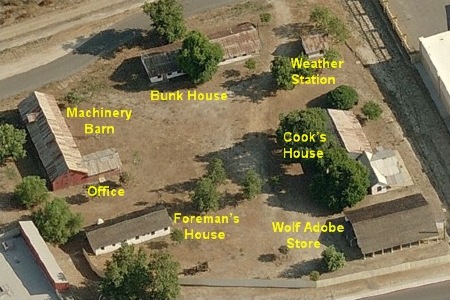
| Vail Headquarters buildings |
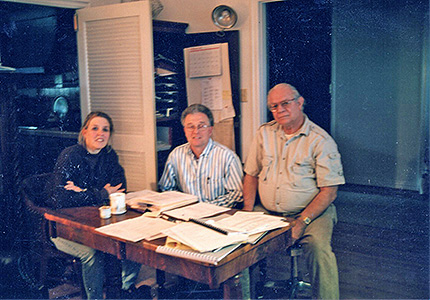
| From
left: The VaRRA Lawsuit Team, 1998 - Rita Gentry, advisor; Darell Farnbach,
plaintiff; and Dick Diamond, plaintiff. Not pictured is Rebecca Farnbach who took the picture. |
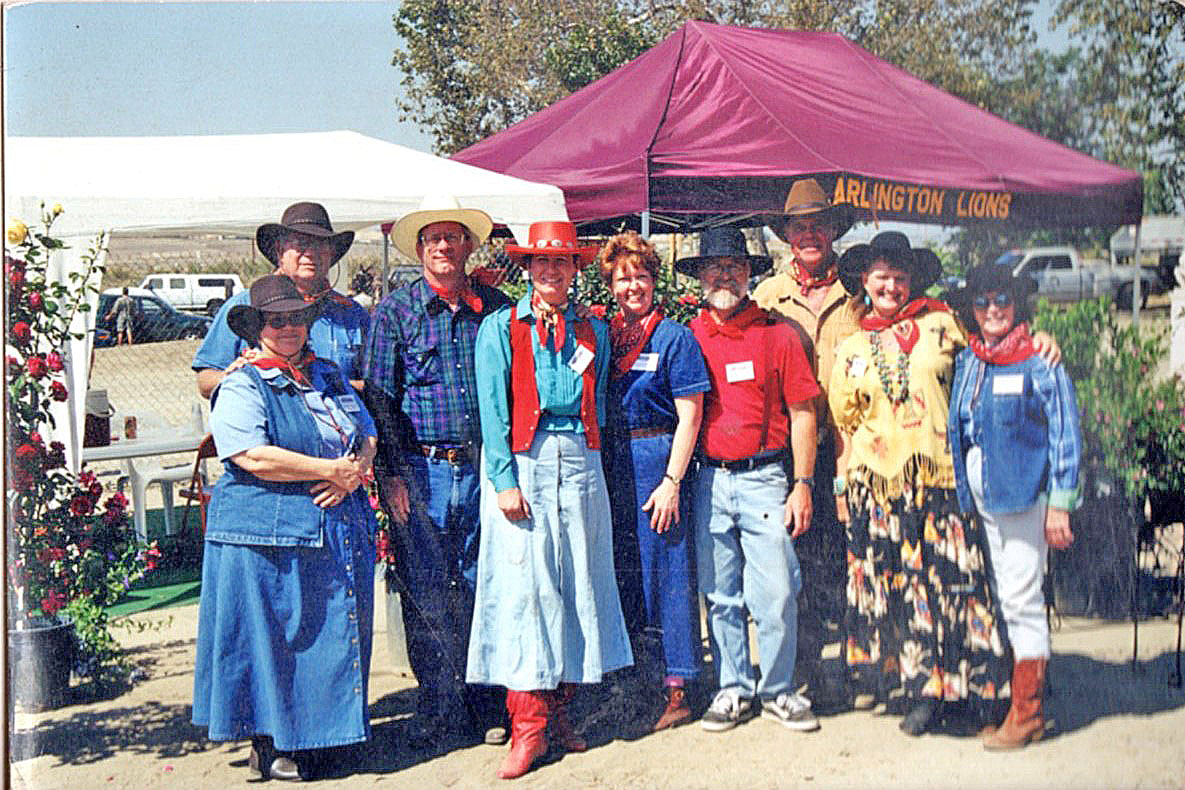
| Betty
& Dick Diamond, Rick & Debbie Busenkell, Rebecca & Darell Farnbach,
Rhine & Sandy Helzer, & a volunteer Photo by Mike McNeff - 1999 - at the first Vail Ranch celebration |
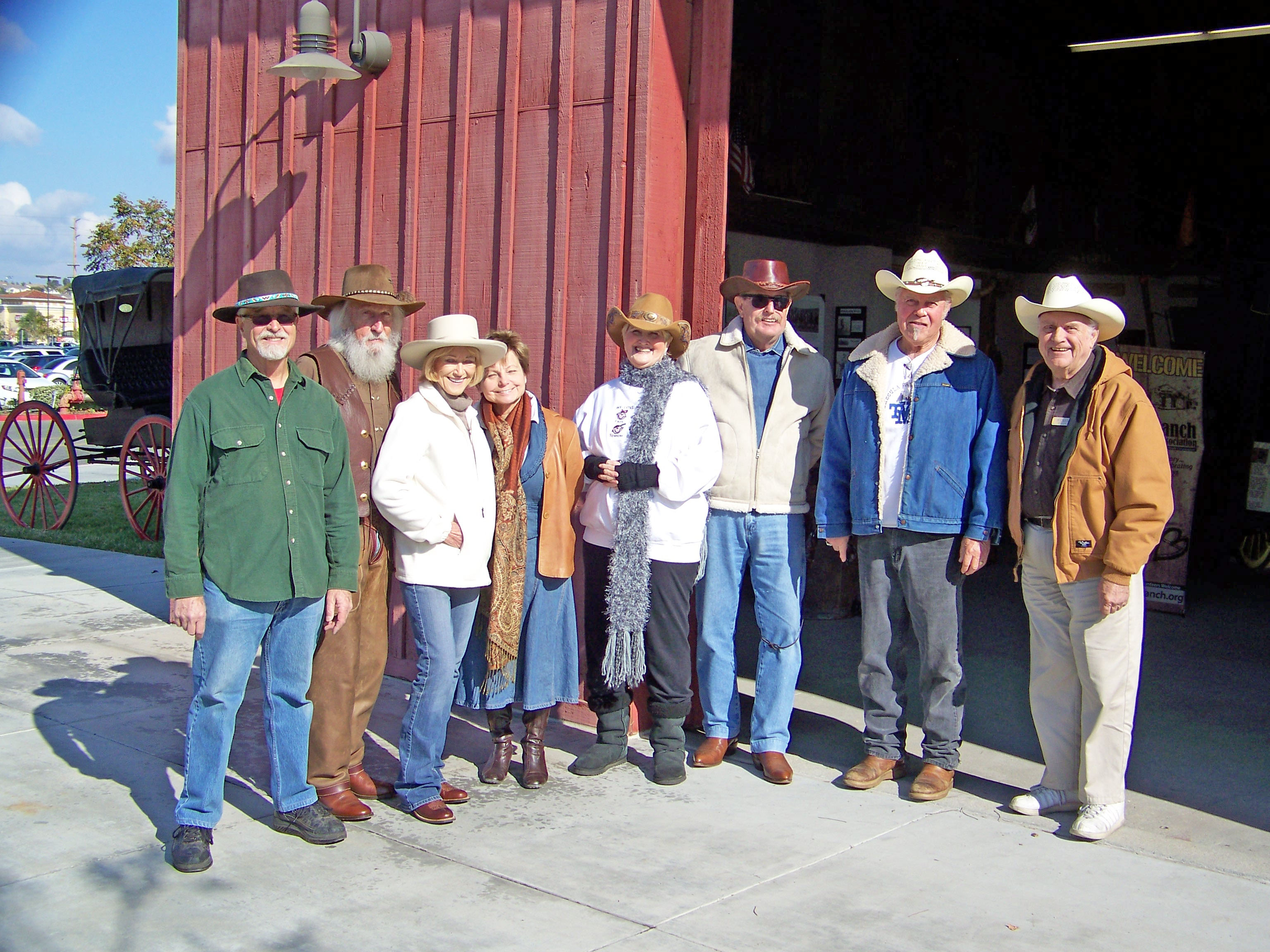
| Darell
Farnbach, Malcolm Barnett, Loretta Barnett, Bonnie Martland, Sandy Helzer,
Duane Preimsberger, Rhine Helzer, Dick Fox Photo by Rebecca Farnbach - 2014 |
| After the Lawsuit to save Vail HQ was successfully settled, VaRRA staged a huge celebration at the site in early 1999 with over 1.000 people in attendance. During the celebration, Dick Diamond, who was the VaRRA President throughout the lawsuit, presented Riverside County Supervisor Bob Buster with a symbolic Vail branding iron as a gift for his participation in the settlement. |
